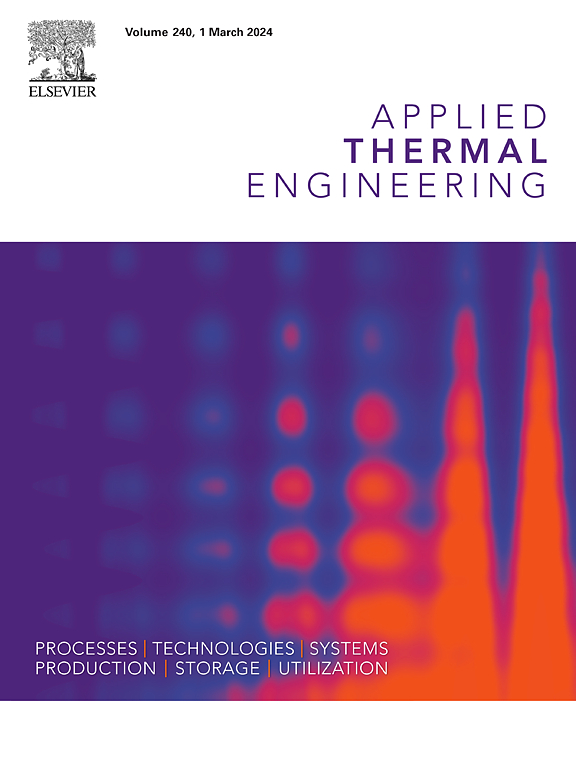纳米增强相变材料在两级抛物面集热器太阳能蒸馏器中的性能评价
IF 6.1
2区 工程技术
Q2 ENERGY & FUELS
引用次数: 0
摘要
全球最紧迫的问题是与可持续能源供应、有效的水循环和综合水管理有关的问题。清洁水的短缺往往因咸水管理不足而加剧,因此需要创新的解决办法。目前的研究探索了一种基于抛物盘太阳能集热器的先进热能储存系统,该系统与脱盐装置集成在一起。该系统使用纯石蜡和各种纳米增强相变材料,包括单、二元和三元构型。该装置包括两个水箱,与抛物面式太阳能集热器和相变材料部分相连接,其中相变材料以不同的相实现:单相(Al2O3, CuO, MWNCNT),二元(Al2O3-CuO, CuO- mwcnt)和三元(Al2O3-CuO- mwcnt)纳米复合材料。本研究分析的关键性能指标包括温度行为、热效率、产水量和经济可行性。结果表明,各相变材料模块的累计产水量分别为4.82、6.95、7.61、8.36、8.88、9.28和9.81 L/m2。在所选的pcm中,三元Al2O3-CuO-MWCNT纳米复合材料的能量效率高达82.46%,每升成本为0.02213美元。值得注意的是,二元纳米增强相变材料的性能优于纯石蜡和单纳米增强相变材料,三元纳米增强相变材料的性能优于二元纳米增强相变材料。这种创新的方法为降低水净化系统的成本和能源需求提供了巨大的潜力,为希望优化其反渗透净化过程的设施提供了经济可行的替代方案。本文章由计算机程序翻译,如有差异,请以英文原文为准。

Performance evaluation of nano-enhanced phase change materials in a two-stage solar still with parabolic dish collector
Among the most pressing global concerns are those related to sustainable energy supply, effective water recycling, and comprehensive water management. Scarcity of clean water is often exacerbated by inadequate saline water management, highlighting the need for innovative solutions. The current study explores an advanced thermal energy storage system based on a parabolic dish solar collector, which is integrated with a desalination unit. This system utilizes pure paraffin wax and various nano-enhanced phase change materials, including mono, binary, and ternary configurations. The setup features two water tanks coupled with the parabolic dish solar collector and phase change material section, where the phase change materials are implemented in different phases: mono (Al2O3, CuO, MWNCNT), binary (Al2O3-CuO, CuO-MWCNT), and ternary (Al2O3-CuO-MWCNT) nanocomposites. Key performance indicators analyzed in this research include temperature behavior, thermal efficiency, water yield, and economic feasibility. The results demonstrate accumulated water yields of 4.82, 6.95, 7.61, 8.36, 8.88, 9.28, and 9.81 L/m2 for each respective phase change materials module. Among the selected PCMs, the ternary Al2O3-CuO-MWCNT nanocomposite possess higher energy efficiency of 82.46 % with the cost per litre of $0.02213. Notably, binary nano-enhanced phase change materials outperforms pure paraffin wax and mono nano-enhanced phase change materials, while ternary nano-enhanced phase change materials exhibits superior performance over binary nano-enhanced phase change materials. This innovative approach offers significant potential for reducing the cost and energy requirements of water purification systems, providing an economically viable alternative for facilities looking to optimize their reverse osmosis purification processes.
求助全文
通过发布文献求助,成功后即可免费获取论文全文。
去求助
来源期刊

Applied Thermal Engineering
工程技术-工程:机械
CiteScore
11.30
自引率
15.60%
发文量
1474
审稿时长
57 days
期刊介绍:
Applied Thermal Engineering disseminates novel research related to the design, development and demonstration of components, devices, equipment, technologies and systems involving thermal processes for the production, storage, utilization and conservation of energy, with a focus on engineering application.
The journal publishes high-quality and high-impact Original Research Articles, Review Articles, Short Communications and Letters to the Editor on cutting-edge innovations in research, and recent advances or issues of interest to the thermal engineering community.
 求助内容:
求助内容: 应助结果提醒方式:
应助结果提醒方式:


